Sweet Te Muri Crossing consensus
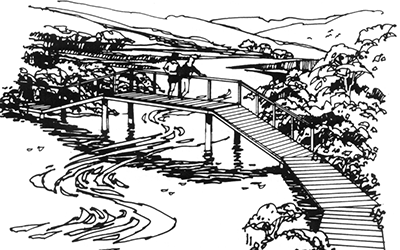
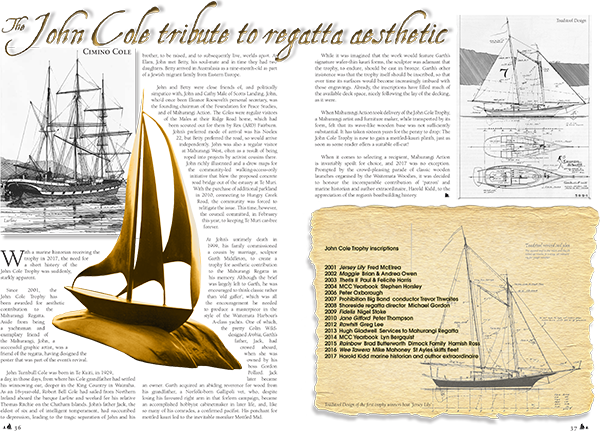
Pre-Lockdown Presentation: Day after the momentous Te Muri crossing consensus, the John Cole Trophy was presented to Snells Beach School, in what necessarily will have been its last physical fortnightly assembly, for the duration of the covid-19 pandemic. spread Mahurangi Cruising Club Yearbook
In its 33-year story, the Mahurangi Coastal Trail has seen some meaningful milestones. Last Thursday’s is one such, particularly tangible trail marker.
Circa 1987, Auckland Regional Parks management had decided where a bridge was to cross Te Muri Stream; it was to run smack across the widest point of the estuary. But that was a relatively minor concern; it was to be full-blown concrete road bridge, emptying into a car park for thousands. The sense of splendid isolation Te Muri had instantly become adored for, was set to be torn asunder.
Fast forward to Thursday 12 March 2020, and not only was the consensus on the crossing point not unilateral—excluding community and mana whenua—it was for a footbridge, reflecting the radical council change of heart, formalised in 2017, making Te Muri officially, splendidly, car-free forever. That decision—technically, a management-plan variation—prioritised a Te Muri all-tide crossing, without prescribing exactly where that be and what form it would take, but noted:
…Te Muri Stream is identified in the [Proposed Auckland Unitary Plan] as highly ecologically significant estuary. It has Outstanding Natural Landscape, High Natural Character (north bank) and is a Significant Ecological Area – Coastal 1 and is recognised as an Outstanding Natural Feature.
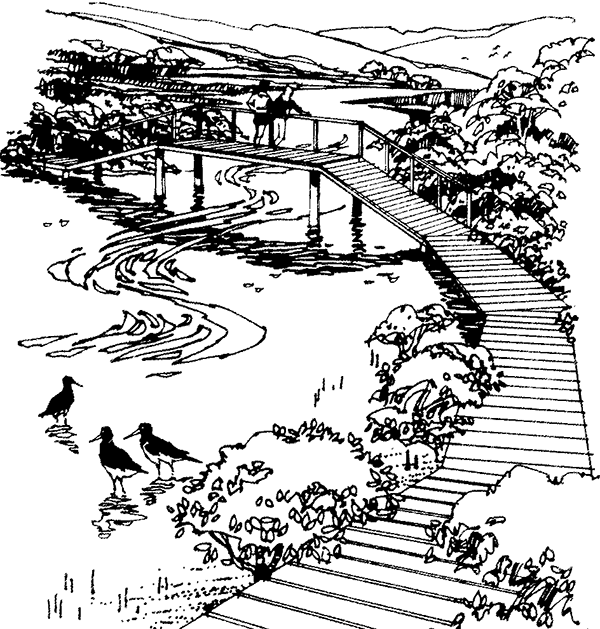
All Aboard the Waka: Although the structure cannot be quite as low-key as this charming John Cole rendering, the crossing point now agreed upon is almost exactly this 1987-depicted location, nicely screened from the body of Te Muri Estuary by mangroves and the low island that the boardwalk will now skirt, rather than run over. visualisation John Cole
That caveat notwithstanding, the commissioners recommended:
that the [management plan] policies relating to pedestrian and cycle access be amended to allow for immediate access [to Te Muri] via Te Muri Stream…
Although a route had been suggested in 1987, when a renewed effort to achieve a Mahurangi Coastal Trail was mobilised in 2012, two additional options were explored. One departed from where most Te Muri visitors have crossed in the 47 years since the land was acquired, as regional park, but rather than land on Te Muri spit, with its sensitive ecological and cultural features, it landed more or less opposite, on the Nokenoke terrace—in fact, all three options respected the spit, in that regard.
The other option, included more for completeness, was considerably farther upstream, and consequently considerably more expensive. But being twice the price as either of the other two options wasn’t its main failing. It would have required Te Muri visitors to detour so far from what is generally their primary objective—Te Muri Beach—that it would have been used only as a last resort. But, although underutilisation of infrastructure is a concern—particularly given the scant total amount invested in non-motorised transportation—the as-important consideration was that it would have encouraged risk-taking in the form of folk attempting to cross the estuary near the top of an outgoing tide.
This concern, to reduce risk taking, was also a principle argument in favour of the recent downstream option. Additionally, it was argued, desire lines would strongly favour a crossing at, or very near, the existing fording point. But that was to ignore the potential for establishing fresh desire lines, beginning from the end of Ngārewa Drive, where walkers have a view of Te Muri Estuary, and none of Te Muri Beach. Then, halfway down the hill, was the road to be redirected to continue on down towards the estuary, and the old road disrupted and partially naturalised, instinct would lead walkers straight to the new crossing.
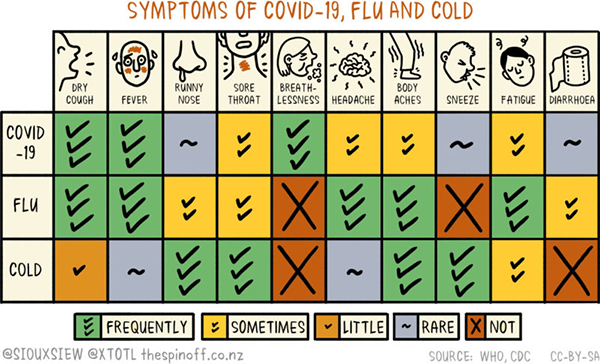
Sealed with a Pre-Social-Distancing Hongi: Although in retrospect irresponsible, at least one euphoric, elderly, can-now-die-happy participant in the 12 March consensus-sealing discussion was delighted to risk contracting covid-19, but simultaneously far from sanguine about the possibility of spreading it. Meantime, until Aotearoa addresses its deplorably inadequate testing capabilities, and not just for this infection, charts such as this are the best guide for those with cold and/or flu symptoms to refer to. Warkworth’s legendary general medical practitioner and Mahurangi Coastal Trail supporter, Dr John Andrews, was warning of the world’s unpreparedness for pandemic fifty years ago. Andrews was exercised that all too few understood the awful magnitude of the 1918 Pandemic—between 50 and 100 million fatalities. graphic The Spinoff
Generations have now camped Te Muri, and many now come complete with carts to haul their equipment and provisions the 1.2 kilometres to the campground, via the estuary, typically during the period a couple of hours either side of low tide. Although the proposed new route is a fraction longer—about 150 metres—it won’t require the contents of the ubiquitous carts to be transshipped at the estuary. Also, nicely planted, in time the walk could be pleasantly shaded. Additionally, consideration could be given to creating a new, campsite on the broad, 3.3-hectare Nokenoke terrace. This would be a boon for hundreds camping there on Auckland Anniversary weekend, to be within an easy stroll of the natural Mahurangi Regatta amphitheatre that are the hillsides of Sullivans Bay. It will require imagination and dedication to ensure that 99% of Te Muri visitor impact is not concentrated on its beach.
Although protection of the urupā and shore-breeding bird habitat is paramount, also important is the need for regional parkland, where practicable, to be access-and-mobility accessible. One possibility is to permit by-arrangement use of the road, extended to the 1300-square-metre natural terrace that sits within maybe four metres of the level of the boardwalk proposed. Providing a trail at a gradient of no more than 1:20 is challenging, but given that the beach is only a 1.0-kilometre all-but-level run from there, those disabled are as at least deserving of enjoying Te Muri’s sense of splendid isolation as anyone.
For those privileged with personal transport, or otherwise readily able to access a regional park, the isolation afforded, and camaraderie at a contagion-safe distance, will be increasingly precious as months of covid-19-caused confinement takes its toll.
First casualty of pandemics As in war, in the covid-19 pandemic, in the age of Donald Trump’s go-to propaganda weapon, “fake news”, and the time of terminally malignant social media, the first casualty is truth:
The government of a country whose indigenous people suffered a five-and-a-half-times-higher rate of mortality during the 1918 Pandemic than its Pākehā-dominant general population has an unparalleled duty to display the transparency called for by Sir David Skegg—epidemiologist at the University of Otago Medical School, former chairman of the Public Health Commission, the Health Research Council, and New Zealand’s Science Board.
Achilles’ Heel of current strategies The following are the two concluding paragraphs of Asymptomatic Transmission, the Achilles’ Heel of Current Strategies to Control Covid-19, published 28 May 2020:
Ultimately, the rapid spread of Covid-19 across the United States and the globe, the clear evidence of SARS-CoV-2 transmission from asymptomatic personsArons MM, Hatfield KM, Reddy SC, et al. Presymptomatic SARS-CoV-2 infections and transmission in a skilled nursing facility. N Engl J Med. DOI: 10.1056/NEJMoa2008457, and the eventual need to relax current social distancing practices argue for broadened SARS-CoV-2 testing to include asymptomatic persons in prioritized settings. These factors also support the case for the general public to use face masks when in crowded outdoor or indoor spaces. This unprecedented pandemic calls for unprecedented measures to achieve its ultimate defeat.

Becoming Wise Before the Event: Despite now experiencing 17 pandemics—and 6 of those since 2002—the world was found to be pitifully ill-prepared for when, with predictable unpredictability, this current pandemic manifested. Preparing for the potentially far-deadlier effects of anthropogenic global heating, as well as being an inescapable existential imperative, can, simultaneously, better equip humanity to respond to epidemics, and prevent more becoming pandemics. Here, the initially all-but-imperceptible case-infection rates displayed for India and Indonesia were grave indicators of governments in desperate denial of their countries’ now-destined roles in the raging pandemic—and early exemplar Singapore demonstrates the ruinous consequences of neglecting its most vulnerable workers. Nigeria, however, scams all 207 million of its citizens, by testing fewer than 1% of them, thus hiding the appalling impact of the pandemic there. Australia long-since lost her battle to keep within cooee of covid-19-test-kit-exporter extraordinaire South Korea’s standout response. Aotearoa, meantime, has flat-lined in a good way. All countries’ infection rates are under-reported, some because a few cases, particularly early in the pandemic, are misdiagnosed, but in other countries monstrously, due to dysfunction and/or lack of transparency. The diameter of each line on this graph is proportional to the country’s population. graph Mahurangi Magazine | data Our World in Data 12 November 2020
Join FluTracking now and help prevent future pandemics…
Salutary Lesson in Seasonal Influenza: Physical distancing has also paid dividends in reducing the annual toll extracted by flu that, despite its deadliness, is treated as an inconvenience rather than the killer it is, particularly of the very young, the elderly, and the pregnant—“On average, approximately 400 deaths are attributed to influenza and its complications annually.” covid-19 provided the opportunity to begin collecting flu-symptom data earlier than was done 2018–2019. graph Department of Health Australia | Ministry of Health Aotearoa | labels Mahurangi Magazine
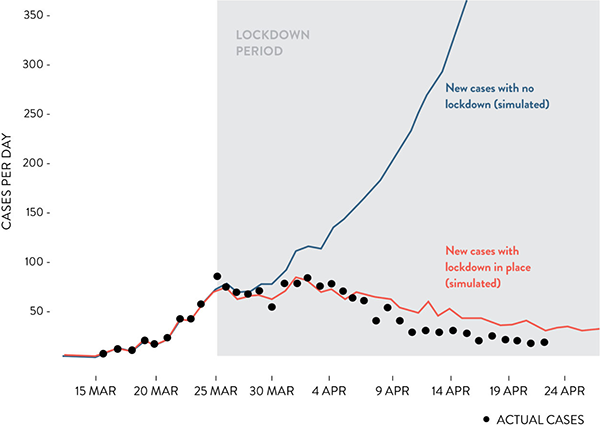
New Zealand’s Altered Future: Moving nine days faster than Ireland, and more emphatically physically distancing, Aotearoa has avoided Ireland’s near vertical trajectory—until the middle of May—of reported covid-19 cases. Ireland’s prime minister then donning his sweats was perhaps great optics, but responding to, for example, fellow general practitioner Dr Marcus de Brun, or to nursing-home representatives more than seven weeks earlier, would have constituted a far more heroic course of action. Aotearoa, for its own survival, now needs to convince the world to alter its determinedly fossil-fuelled future. chart New Zealand Geographic | Te Pūnaha Matatini
